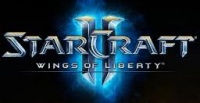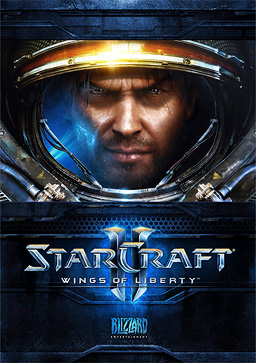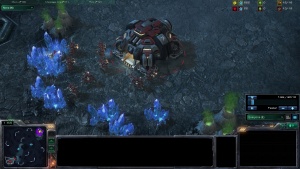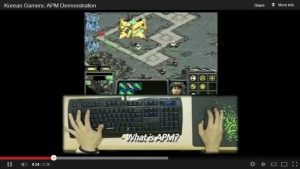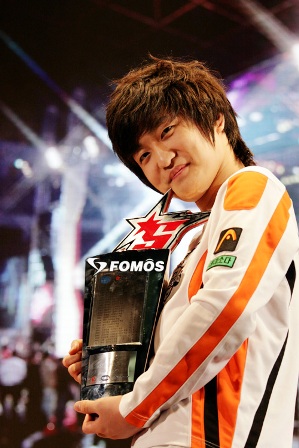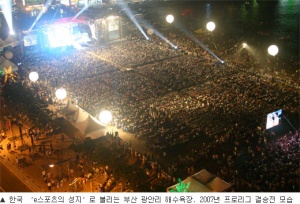Starcraft II
|
Starcraft II: Wings of Liberty is a real-time strategy game developed and published by Blizzard Entertainment. [1] It is the sequel to the original Starcraft series and the first game of the Starcraft II trilogy and is available for Microsoft Windows and Mac OS X.[2][3] The game sold over 1 million copies in the first 24 hours of release, and holds the record for fastest-selling strategy game of all time. [4]
Just like in the original Starcraft, players must collect resources, build structures, and train units with which to defeat their opponents. [5] Starcraft II: Wings of Liberty features a campaign (single player) mode, online multiplayer, and an editor for custom map makers. The game has received high praise from critics and players alike and is currently considered one of the most popular Electronic Sports ("e-sport") titles in the world. [6] There has been criticism of the game as well as a number of ethical issues surrounding piracy and other forms of misuse of the software.
As of April 9, 2017 the game has two expansion packs, Starcraft II: Heart of the Swarm which was released on March 12, 2013, and Starcraft II: Legacy of the Void which was released on November 10, 2015. The original game follows the story line of the Terran race while the two expansion packs further the story from the viewpoint of the Zerg and Protoss races, respectively. [7][8]
Campaign
Starcraft II: Wings of Liberty's single player campaign follows protagonist Jim Raynor in a battle to save humanity from the tyranny of Arcturus Mengsk, the recent Zerg invasion led by the Queen of Blades, and the threat of Protoss-Zerg hybrids whose intentions are unknown. The campaign features 29 missions with unique features and objectives to complete.[9] The campaign gameplay focuses on the Terran race, with a few of Protoss missions. Players are introduced to a number of new characters who play a role in the storyline as well as returning characters from the previous game. Players receive currency (credits) for completing missions and bonuses for completing them in special (often more difficult) ways, with which they may spend on upgrades to existing units or mercenaries to aid them in subsequent missions.[9] The single player features 4 difficulty modes: Casual, Normal, Hard, Brutal. [9]
Gameplay
Much like in other military RTS titles, gameplay in Starcraft II is focused primarily on military strategy, understanding of game mechanics, and precise unit control. The very best players are those who excel at all three of these skills.There are many important aspects to successful gameplay in Starcraft II, several of which are listed below.
Macro
Short for "macromanagement", "macro" is a term that refers in context to the practice of managing the larger-scale aspects of the game. Grand military strategy, endgame goals, large-scale unit movements, and surveilling the opponent to reveal their own strategy are practices that fall under the umbrella of "macro". The idea of macro is that it covers overarching strategy rather than the specifics of a small battle, or the usage of a single unit, which is considered "micro" (see below). The harvesting of resources and management of the player's "economy" is a critical aspect of macro.
Players start out with a central command structure (Command Center for Terran, Hatchery for Zerg, Nexus for Protoss) and a small group of harvesting units and must expand their presence by gathering "minerals" and "vespene gas". Building structures and training additional units costs one or both of these resources. Players must also obtain supply in order to be able to support more units and trying to create more units without enough supply is known as a "supply block" within the community. Creating units, buildings, and supply as well as minimizing the idling time of harvesting units and structure build queues is known as "Macro" and is the primary indicator of a good player. [10]
Micro
Short for "micromanagement", "micro" is a game term that refers in context to the ability to control and optimize game actions on a very small scale. While macro consists of controlling the match as a whole, effective micro consists mainly of actively reducing the amount of time spent on common actions, positioning and placing units to be most effective in combat, and timing and targeting units' abilities optimally.
Another primary aspect of micro is the ability to optimize the placement and effectiveness of units. Many units in Starcraft II have abilities that can turn the tide of a battle if used correctly. Being able to identify both the best moment for and best use of a certain ability is integral to effective micro. Similarly, the placement of units within a formation can entirely affect the outcome of a skirmish. For example, ranged units in Starcraft II are often fragile, but can be placed behind the typically more robust melee units, allowing them to engage targets without being attacked themselves. Additionally, effectively moving units into a wider or more spread formation can allow them to avoid large area-of-effect attacks or surround an enemy force. Because skirmishes in Starcraft II are typically over in a matter of seconds, doing this quickly and correctly is very challenging.[11]
Strategy
Strategy in Starcraft II revolves around the exchange of information between players. Many units in Starcraft II can provide significant value depending on the enemy the unit faces, making strategy an essential tool to win. Gaining information from an opponent while hiding a player's own information is an example of strategy. Using information on an enemy allows a player to craft an army tuned to defeating the enemy. A player can choose to focus on creating as many units as quickly as possible to overwhelm an opponent early, or a player may focus on immediately investing in economy to gain an advantage later in the game. Maps often play a role in deciding what strategy to use. Features like the placement of cliffs, wideness of ramps, distance from opponent, amount of airspace, and number of paths to your opponent all factor into a chosen strategy. Some strategies are also better suited towards a particular player. For instance, player's with good Micro skill may favor technical "All-Ins" where success is solely based upon unit control and execution. Due to the amount of units, the array of maps (which are ever-changing), and the 9 possible racial match-ups, understanding Starcraft II strategy takes problem solving, critical thinking, and many logged games of experience.[12] Team Liquid contains a large and maintained list of strategies, sorted by race match up. [13]
Cheese Strategies
Cheese is a term used to describe certain strategies that aim towards winning the game as quickly as possible or relying entirely on one aspect of the game hoping your opponent is unprepared to exploit its weakness. These strategies are most effective when an opponent is unable to gain information on the early incoming attack. The most common cheese strategies for each race are the six pool (Zerg), [14] the Photon Cannon Rush (Protoss), [15] and the Thor Rush (Terran). [16] Cheese is an essential part of Starcraft II strategy.
APM (Actions Per Minute)
A key measure of a player's skill is the amount of actions (clicks, keypresses, etc.) they make in a minute, known as APM (Actions Per Minute). Players skilled at micro seek in part to increase their APM by cutting out as much of the time involved in an "action" as possible. [17]
Reducing the amount of time a player spends performing actions such as selecting units, pressing buttons, and moving the game camera is a primary aspect of micro. The theory is that, by reducing the amount of time spent on such actions, the player will have more time to invest in productive tasks and is able to respond more quickly to threats. For example, each action, unit skill, or building from the build menu is presented in a grid in the corner of the screen. New players typically move the mouse to the appropriate button to select it, but each button has a specific "hotkey" which is unique to it that can be pressed in lieu of manual selection. Skilled players typically memorize these hotkeys to speed up the rate at which they can perform tasks. [18]Despite a positive correlation between APM and skill level, Players with low APM have reached high levels of professional play, [19] relying on alternate strategies that do not require high APM.
E-Sport
Designed from the ground up for the purpose of being played professionally, Starcraft II is one of the most popular e-sports in the world. Garnering support from it's predecessor's fanbase (Starcraft and Starcraft: Brood War), which was only hugely popular in South Korea.[20] Starcraft II has found much more success in Europe and the Americas. [21] Tournaments (both offline and online) are featured everyday with major tournaments boasting prize pools of $150,000+. [22] Currently, the most prestigious and lucrative tournament is the GSL (Global Starcraft II League), although other big-name leagues have adopted the game since it's release, specifically in the West. MLG (Major League Gaming), ESL, DreamHack, IEM, IPL and others are among these. [22]
The success of Starcraft II as an e-sport can be attributed to both the developers and it's community. Games are viewable by spectators live without affecting the players and the feature-rich interface makes knowing what is happening transparent. Statistics such as the players' harvester count, supply count, current income, units lost, current production, APM (Actions Per Minute) are all available to casters during the game via tabs. Map vision may be restricted to one player or both, and the casters camera may be synced with a player's to deliver the game from that player's viewpoint.
Starcraft II's community, which largely clusters around Team Liquid [13], is supportive of the game's longevity and further success in the e-sport scene in a number of ways. Fans from "newbs" to pros discuss strategy and competitions, watch live streams of players or tournaments, and form groups for online play. There is also a dedicated map-making community that makes use of the editor to make fun custom games, and/or serious melee maps for possible tournament use. Starcraft II's fanbase has proven loyal since the release in 2010 and the game observability has allowed casual or former players to enjoy watching even if they themselves do not intend to play at a high level. [23]
The skill levels in Starcraft II are divvied up by "League." There are seven Leagues. In rising order of skill, these are Bronze, Silver, Gold, Platinum, Diamond, Master and Grandmaster League. One can ascend through the leagues by winning games in online matches. Playing with the intent of bettering one's League rating is called "laddering" because everyone plays on a sliding ladder of skill rankings, that is constantly in flux.
Criticism
Despite a hugely successful launch in all regions, Starcraft II has suffered criticisms ranging from it's "newb-friendly" interface to it's online-only playability. [24]
DRM
Online-only playability, has received harsh criticism from players, especially from those living in areas where internet access is not consistent and from fans of the original Starcraft which had LAN support. [25] The latter has been the cause of several controversial games where a player has disconnected from the Battle.net service during a high-stake game of a live tournament. [26] This was not a problem with the LAN-supported Starcraft and Starcraft: Brood War. In response to the backlash, Blizzard has responded by chalking it's refusal to implement LAN support as a safeguard against piracy. [27]
Improved AI
Other criticisms of the game stem largely from a select group of original Starcraft fans claiming that the game's improved AI and user interface allows for lower-skilled players to perform better than they should. Professionals of the original game who are now transitioning to Starcraft II believe the game's simple control scheme has made the multitasking and hand speed less important and has as a result, lowered the skill ceiling of the game. [28]
Professional South Korean Gaming Community
After its release, many Southern Korean teams chose not to migrate over to Starcraft II due to criticisms over Starcraft II not having adequate game mechanics. Mechanics that originally posed challenge to gamers in Starcraft Brood Wars were no longer present in Starcraft II. Professioanl South Korean gaming communities also criticized the Starcraft II of being immature and full of vulgar. [29]
Ethical Issues
Piracy
In November 2010, Starcraft II set the piracy record with 2.3 million illegal downloads. With the popularity of the game, and the amount of people on the internet, it seems inevitable that the game will be downloaded illegally, making piracy a significant issue.[30] Blizzard has combated pirates, albeit at the expense of it's legitimate player-base, by requiring users to be online and authenticated by Battle.net servers.[31] However, this method is still susceptible (albeit not as much) to piracy, raising ethical concerns about the validity and fairness of the Starcraft community and player base.
Addiction
Video game addiction represents a concern for real time strategy games such as Starcraft II. According to a 2010 survey by the National Information Society Agency about 14% of Koreans ages 9 to 12 suffer from Internet and gaming addictions. Professional players such as MarineKing and MVP play on average 12 to 14 hours per day with only breaks to use the restroom, eat a quick snack, and sleeping. Players who become addicted develop bad habits of ignoring their surroundings as if it is just the player and their digital world in Starcraft II. There are some extreme cases where players have died from days without rest mainly in South Korea where gaming is multi-billion dollar industry.[32]. This raises ethical concerns because popular and addicting video games such as Starcraft II can captivate the younger generation into heavily investing in a video game, wasting time, and neglecting other responsibilities such as education. While the issue has been raised in the gaming community, the profits that the industry can capture on young and even older players is still too large for massive reforms to take place as most people are willing to ignore and gloss over the issue. Blizzard only stands to gain from more and more players who play the game and become more invested in Starcraft II, raising the chances of revenue from the game and other similar Blizzard games and ultimately adding to the value of the brand, which means that support for those willing to stop or halt the video game addiction concerns must come from those outside of the video game industry system.
Cheating
Like most games, Starcraft II has a small issue of cheating. Because the game requires authentication through the Battle.net servers, cheating can only be done via scripts and alterations to the game client that go unnoticed when the game is launched. While cheating has not been a rampant issue for Starcraft II, Blizzard has taken a firm stance against it and routinely bans the accounts associated with such behavior in hopes of deterring players from cheating.[33] Thus, the minor presence of cheating is a relatively small concern compared to the other ethical issues of Starcraft II, and is moderated at a comfortable and satisfactory level for both Blizzard and Starcraft II players.
Smurfing & Win-Trading
Smurfing (creating accounts for the purpose of playing at a matchmaking rating below a player's capability to defeat lesser players) is one of the biggest issues for Starcraft II, specifically for lower level players. Several of the grandmaster and master level players have purchased secondary accounts with which they purposely throw games in order to land a lower MMR (matchmaking rating). Blizzard has made statements claiming they do not support smurfing, win-trading, or any behavior where games are purposely lost in order to thwart the matchmaking system.
Win-trading refers to the behavior of using accounts to elevate the MMR of a particular account. It is done by fixing the time when two accounts enter matchmaking so that they are matched and quitting with one of the accounts to increase the MMR of the other.[34] This practice is looked down upon by Blizzard and the general Starcraft II community, but many players opt to do this because it allows them to smurf and play around with their accounts and matchmaking potential.
2015 Match Fixing Scandal
In 2015, brokers and financial backers offered Lee "Life" Seung Hyun $70,000,000 to purposefully throw two matches in May of 2015. Jung "Bbyong" Woo Yong was also offered $30,000,000 to lose a match in January 2016.[35] Professional players 'YoDa' and 'BBoongBBoong' and professional coach 'Gerrard' were investigated starting in August 2015, arrested, found guilty of fixing five matches, and banned for life from participating in Starcraft tournaments.[36] The alleged brokers have also been found guilty of giving payments to the gamers and placing bets for the financial backers.[37] KeSPA stated that they have a zero-tolerance policy in regards to illegal gambling and fixing matches.[38]
See Also
References
- ↑ Blizzard Entertainment. Blizzard Entertainment: StarCraft II
- ↑ April 9th, 2010. Top News. Blizzard Entertainment Comes Up with Starcraft’s Sequel
- ↑ Wikipedia. http://en.wikipedia.org/wiki/StarCraft_II:_Wings_of_Liberty
- ↑ August 3rd, 2010. Joystiq. StarCraft 2 sells 1m day-one, 1.5m in first 48 hours, roughly 620K in the US
- ↑ Blizzard Entertainment. StarCraft II™ Beginner's Guide
- ↑ March 4th, 2011. Gamespot. Starcraft II: The making of an e-sport
- ↑ Ocampo, Jason · (October 10, 2008) · Blizzcon 08: StarCraft II Split Into Three Games · work · IGN · April 9, 2017
- ↑ Rausch, Allen · (October 10, 2008) · StarCraft II is Now a Trilogy · work · GameSpy · April 9, 2017
- ↑ 9.0 9.1 9.2 Blizzard Entertainment. StarCraft II: Campaign
- ↑ liquipedia Starcraft II Macro
- ↑ Blizzard Entertainment · (February 22, 2017) · Pro StarCraft II Explained: Micromanagement · work · Blizzard Entertainment · April 9, 2017
- ↑ lastname, firstname · (date) · Starcraft II Multiplayer Tips · work · Blizzard Entertainment · April 9, 2017
- ↑ 13.0 13.1 Team Liquid. Team Liquid
- ↑ Liquipedia. The StarCraft II Encyclopedia: 6 Pool
- ↑ Liquipedia. The StarCraft II Encyclopedia: Photon Cannon Rush
- ↑ Teamliquid Teamliquid Forums: Perfecting the thor rush
- ↑ Liquipedia. The StarCraft II Encyclopedia: APM
- ↑ BWChart. BWChart Replay Analyser
- ↑ Liquipedia: Goody Starcraft II Professional liquipedia.net
- ↑ OnGameNet Starleague (OSL): Korean broadcasted starcraft tournament liquipedia.net
- ↑ Liquipedia. The StarCraft II Encyclopedia: South Korean SC2 Scene
- ↑ 22.0 22.1 Liquipedia. The StarCraft II Encyclopedia: Premier Tournaments
- ↑ August 6th, 2011. Team Liquid. Team Liquid: Do people watch starcraft but don't play it?
- ↑ March 10th, 2010. CVG. Starcraft 2: 'No chance' of LAN support
- ↑ Petition Online. LAN in Starcraft 2 Please Petition
- ↑ April 8th, 2012. Mineski. Prime wins 5-2 over StartaleQ in GSTL finals
- ↑ July 1st, 2009. Tom's Hardware. StarCraft II LAN Dropped Thanks to Piracy
- ↑ Gosu Gamers. Bisu talks SC2: 'The easier controls make my multitasking less impactful'
- ↑ February 18th, 2011. Duskbin. Brood War Veterans Dislike Starcraft 2
- ↑ November 16th, 2010. Techspot. StarCraft II sets piracy record with 15.77PB downloaded
- ↑ July 30th, 2009. Joystiq. Blizzard combats piracy by cutting LAN support
- ↑ CNN. CNN: Gaming Reality
- ↑ June 30th, 2009. Joystiq. Cheating in Starcraft II
- ↑ Joystiq. Win-trading in Starcraft II
- ↑ BBC News. “Starcraft 2: E-Sport Stars Charged with Match Fixing.” BBC News, BBC, 25 Apr. 2016, [1]
- ↑ Liquipedia. “2015 Match-Fixing Scandal.” Liquipedia, 24 Oct. 2017, 11:30, liquipedia.net/starcraft2/2015_Match-Fixing_Scandal#Arrest_of_YoDa.2C_BBoongBBoong_and_Gerrard.
- ↑ BBC News. “Starcraft 2: E-Sport Stars Charged with Match Fixing.” BBC News, BBC, 25 Apr. 2016, [2]
- ↑ Liquipedia. “2015 Match-Fixing Scandal.” Liquipedia, 24 Oct. 2017, 11:30, liquipedia.net/starcraft2/2015_Match-Fixing_Scandal#Arrest_of_YoDa.2C_BBoongBBoong_and_Gerrard.
